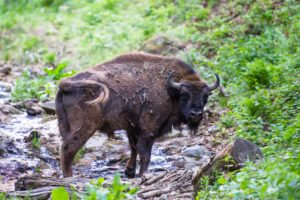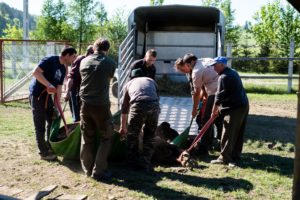Rewilding Europe and WWF-Romania start a new bison release site in Romanian Carpathians

European bison released at the new bison rewilding site in Romanian Poiana Ruscă Mountains. The new site will support the creation of a genetically and demographically viable European bison population in the Southern Carpathian mountain range.
Bogdan Comanescu / LIFE Bison
As part of the larger European bison reintroduction initiative in this region, supported by the European Commission through the LIFE Nature programme, this new bison release site will play an important role in bringing back this species where it once roamed. The first two animals were relocated from the Bison Valley Nature Reserve in Brasov county.
An additional two animals from here were transported to the Țarcu Mountains near Armenis, our existing release area, some 50 km further south. These relocations mark the start of the 5th annual bison release that Rewilding Europe is doing in cooperation with WWF Romania, with 19 animals more to follow in the coming week.
It took two years of intense preparation before the local authorities and communities in Poiana Ruscă were finally ready to welcome these first bison. The site was carefully selected by the expert teams of Rewilding Europe and WWF Romania as it will support the creation of a genetically and demographically viable European bison population in the Southern Carpathian mountain range.

The first European bison released at the new site in the Poiana Ruscă Mountains.
Bogdan Comanescu / LIFE Bison
Located in a key wildlife corridor, Poiana Ruscă is strategically positioned to create such conditions and ensure connectivity and genetic diversity in these two sub-populations.
“The releases taking place this May bring us closer to our goal of having 100 free roaming European bison in the Southern Carpathians“ says Alexandros Karamanlidis, Regional Manager of Rewilding Europe. “We are extremely grateful to the municipalities of Armeniș and Densuș and many national and international partners for making this possible, and to European Commission for supporting our efforts.”
Having been hunted to extinction in Romania around 200 years ago, the European bison made a wild return to the country in 2012 (in the Vanatori Neamt Nature Park). Since 2013, Rewilding Europe and WWF Romania have been working together in the Southern Carpathians rewilding area to establish a free-roaming, viable population of this iconic and key-stone animal. The first two bison releases took place in 2014 and 2015. Since then, additional releases are being done as part of the European Commission – funded LIFE Bison Project.
“The opening of the new release site in Poiana Ruscă is the biggest step so far in the joint efforts of our two organizations to ensure a viable bison population in this part of Romania”, explains Marina Druga, LIFE Bison Project Manager. “This can only be done if the species is released in more areas, not just one”.
Smooth local transfer
The transports that Rewilding Europe and WWF Romania are jointly organising since 2013, involve animals coming from a different range of European countries. However, the release carried out last week was the very first translocation within Romania itself.

The bison journey started in the Bison Valley Nature Reserve and was the very first translocation within Romania itself.
Bogdan Comanescu / LIFE Bison
The journey started in the Bison Valley Nature Reserve, in Brasov county, and was supported by the Romanian Wilderness Society’s bison selection and transport advisors. The journey was just over 350 kilometres and took 8 hours.
“The trip is the easy part, but much more demanding are the preparations, from getting the trailer ready, herding the selected bison in position for sedation, taking blood samples to mounting collars and loading “by hand” onto the trailer.” – said Roland Hauptman, Bison Ranger and the one driving the bison to their new homes.
Four Bison Rangers, assigned through the LIFE Bison project, made sure that the conditions at the release site are favourable and assisted with the transport. The field team made regular stops during the trip, providing water to cool the bison and to carry out veterinarian checks.
Bison on the way
In the next two weeks, twelve more bison will arrive at Poiana Ruscă, coming all the way from Springe Bison Reserve in Germany, while seven more animals will be transported from several German reserves and Italian Parco Natura Viva to the Țarcu Mountains release area.
The animals will be released into the wild from their enclosure after they have undergone a two-month acclimatisation period. From that moment onwards, they will be monitored by the Bison Ranger team, as is the case with the previously released herds. This is another crucial step for the European bison to become a full part of the these Natura 2000 sites of the Țarcu and Poiana Ruscă Mountains Corridor.
The reintroduction of the European bison has a profound impact on the local society, apart from its ecological impact. The species represents a wider vision for the region, that will see wilder nature become an engine for regional development, bringing a new perspective for local communities. This is being made possible through associated efforts in developing nature-based tourism, community development, education, scientific research, technological innovation and conservation efforts that benefit both nature and people.
Read more:
- Read more about the LIFE Bison project here.
- Learn more about the Southern Carpathians rewilding area here.
- Visit the Rewilding Southern Carpathians Facebook page here.




